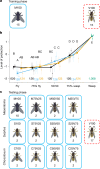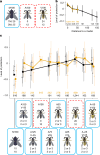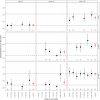Mapping the adaptive landscape of Batesian mimicry using 3D-printed stimuli
- PMID: 40604276
- PMCID: PMC12367557
- DOI: 10.1038/s41586-025-09216-3
Mapping the adaptive landscape of Batesian mimicry using 3D-printed stimuli
Abstract
In a classic example of adaptation, harmless Batesian mimics gain protection from predators through resemblance to one or more unpalatable models1,2. Mimics vary greatly in accuracy, and explaining the persistence of inaccurate mimics is an ongoing challenge for evolutionary biologists3,4. Empirical testing of existing hypotheses is constrained by the difficulty of assessing the fitness of phenotypes absent among extant species, leaving large parts of the adaptive landscape unexplored5-a problem affecting the study of the evolution of most complex traits. Here, to address this, we created mimetic phenotypes that occupy hypothetical areas of trait space by morphing between 3D images of real insects (flies and wasps), and tested the responses of real predators to high-resolution, full-colour 3D-printed reproductions of these phenotypes. We found that birds have an excellent ability to learn to discriminate among insects on the basis of subtle differences in appearance, but this ability is weaker for pattern and shape than for colour and size traits. We found that mimics gained no special protection from intermediate resemblance to multiple model phenotypes. However, discrimination ability was lower in some invertebrate predators (especially crab spiders and mantises), highlighting that the predator community is key to explaining the apparent inaccuracy of many mimics.
© 2025. The Author(s).
Conflict of interest statement
Competing interests: The authors declare no competing interests.
Figures









Similar articles
-
Prescription of Controlled Substances: Benefits and Risks.2025 Jul 6. In: StatPearls [Internet]. Treasure Island (FL): StatPearls Publishing; 2025 Jan–. 2025 Jul 6. In: StatPearls [Internet]. Treasure Island (FL): StatPearls Publishing; 2025 Jan–. PMID: 30726003 Free Books & Documents.
-
Sexual Harassment and Prevention Training.2024 Mar 29. In: StatPearls [Internet]. Treasure Island (FL): StatPearls Publishing; 2025 Jan–. 2024 Mar 29. In: StatPearls [Internet]. Treasure Island (FL): StatPearls Publishing; 2025 Jan–. PMID: 36508513 Free Books & Documents.
-
Is temporal synchrony necessary for effective Batesian mimicry?Proc Biol Sci. 2025 Jan;292(2039):20241737. doi: 10.1098/rspb.2024.1737. Epub 2025 Jan 22. Proc Biol Sci. 2025. PMID: 39837508
-
Tobacco packaging design for reducing tobacco use.Cochrane Database Syst Rev. 2017 Apr 27;4(4):CD011244. doi: 10.1002/14651858.CD011244.pub2. Cochrane Database Syst Rev. 2017. PMID: 28447363 Free PMC article.
-
Sertindole for schizophrenia.Cochrane Database Syst Rev. 2005 Jul 20;2005(3):CD001715. doi: 10.1002/14651858.CD001715.pub2. Cochrane Database Syst Rev. 2005. PMID: 16034864 Free PMC article.
References
-
- Bates, H. W. Contributions to an insect fauna of the Amazon Valley. Lepidoptera: Heliconidæ. Trans. Linn. Soc. Lond.23, 495–566 (1862).
-
- Ruxton, G. D., Sherratt, T. N. & Speed, M. P. Avoiding Attack: The Evolutionary Ecology of Crypsis, Warning Signals, and Mimicry (Oxford Univ. Press, 2004).
-
- Leavey, A., Taylor, C. H., Symonds, M. R. E., Gilbert, F. & Reader, T. Mapping the evolution of accurate Batesian mimicry of social wasps in hoverflies. Evolution75, 2802–2815 (2021). - PubMed
-
- Penney, H. D., Hassall, C., Skevington, J. H., Abbott, K. R. & Sherratt, T. N. A comparative analysis of the evolution of imperfect mimicry. Nature483, 461–464 (2012). - PubMed
-
- McLean, D. J., Cassis, G., Kikuchi, D. W., Giribet, G. & Herberstein, M. E. Insincere flattery? Understanding the evolution of imperfect deceptive mimicry. Q. Rev. Biol.94, 395–415 (2019).
MeSH terms
LinkOut - more resources
Full Text Sources

